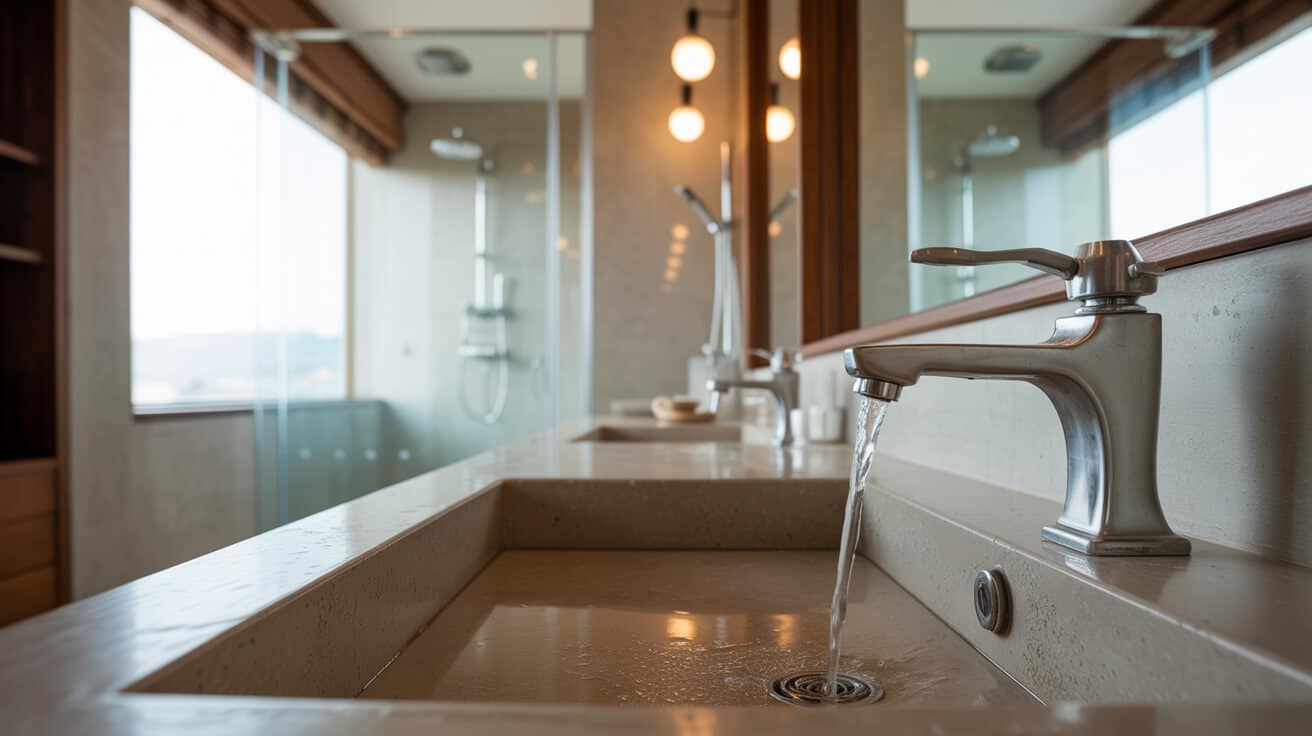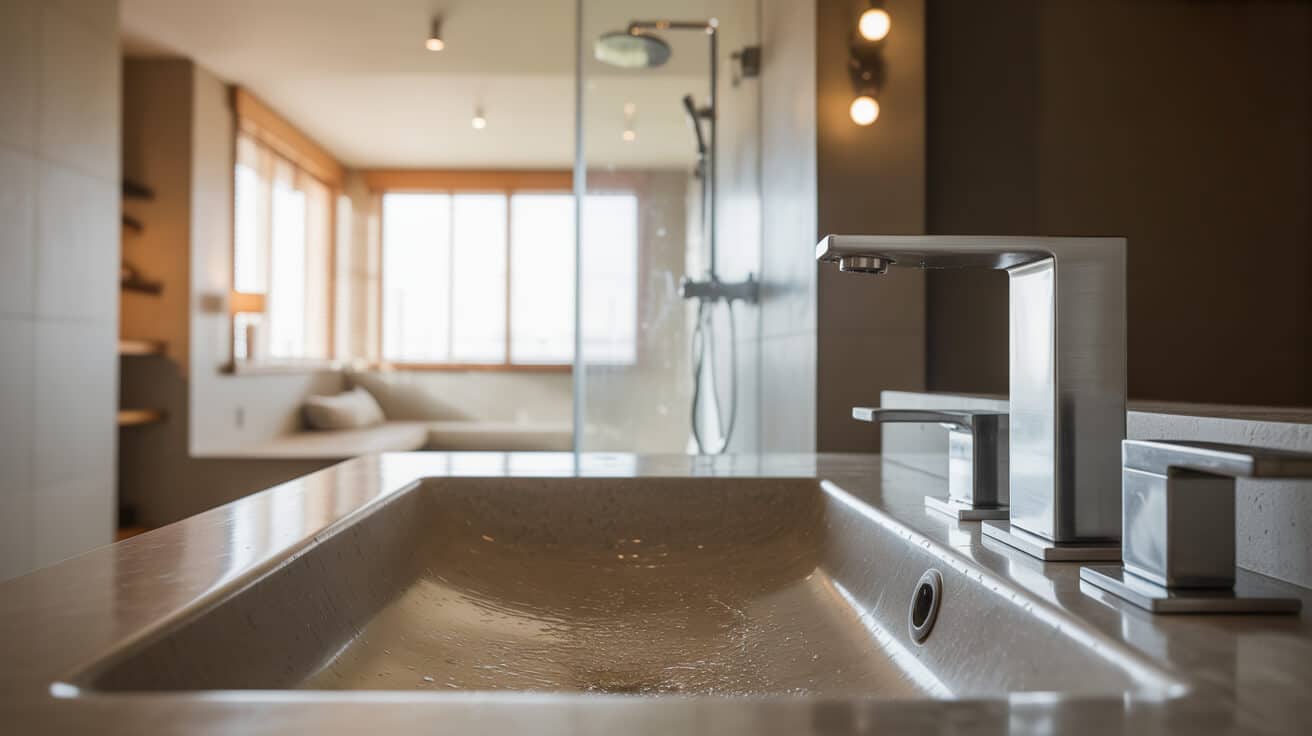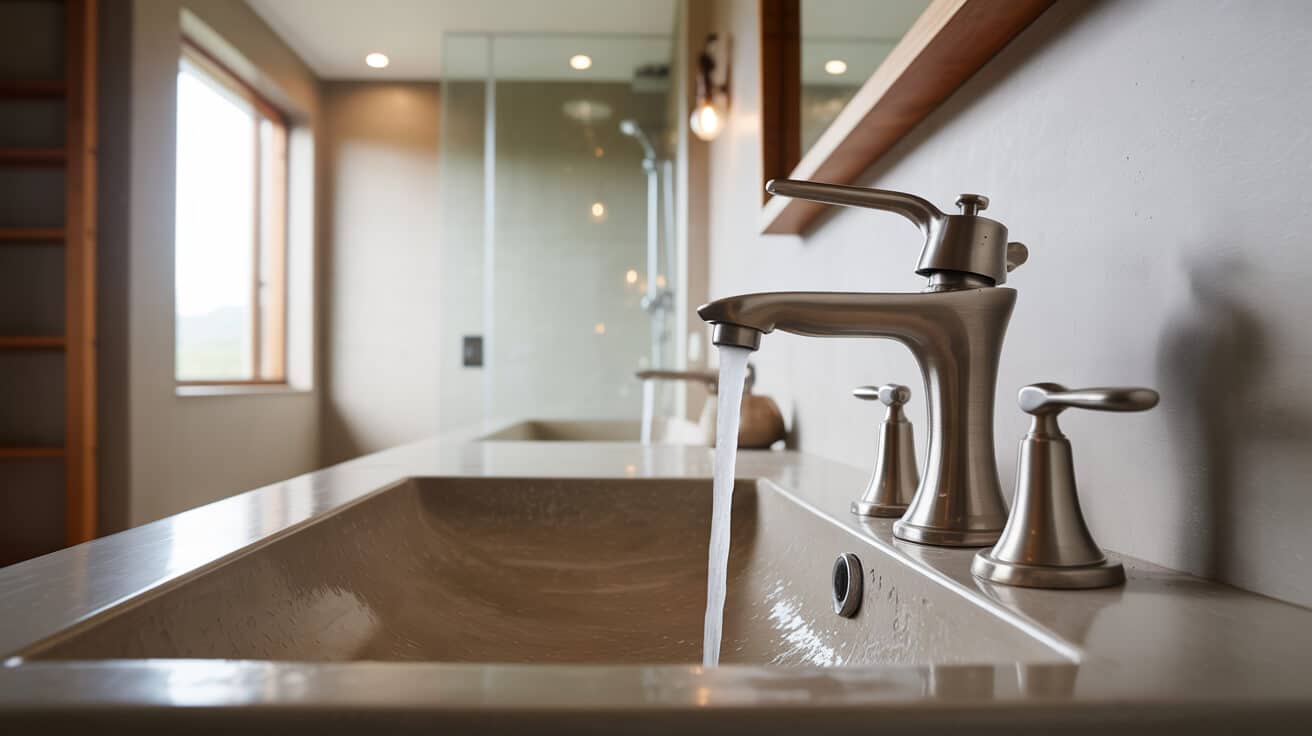Scale formation in hot water systems occurs as mineral-laden supply water passes through environments where heat prompts the insolubility of bicarbonate minerals. As dissolved calcium and magnesium interact with heating surfaces—including cylinders, boilers, and pipes—microscopic crystals nucleate and layer over time, thickening to create dense deposits. These mechanisms drive system inefficiency and physical deterioration, underscoring the importance of deliberate water quality management and preventive maintenance for any building with hot water circulation.
In real-world property contexts, the economics of limescale relate not only to direct energy loss and repair expense, but also to downstream factors such as insurance eligibility, warranty purity, and tenant or user satisfaction. The challenge is intensified in regions supplied by groundwater with naturally high mineral concentrations, necessitating a blend of technological, procedural, and behavioural strategies to sustain reliable hot water service.
Etymology or name origin
The term “limescale” combines the word “lime”—a historical designation for calcium-rich minerals in geology and chemistry—with “scale,” which, in industrial terms, denotes undesirable mineral crusts forming in machinery or infrastructure. First prominent in British trade discourse of the Victorian era, the concept gained technical limitation as steam heating and pressurised plumbing revealed new failure modes due to internal incrustations. Analogous language—such as “carbonate scale,” “mineral fouling,” and “calcareous deposit”—arises in international engineering sources, but the British “limescale” most commonly signals the specific threat of thermally-induced carbonate precipitation in potable water appliances. It is importantly distinguished from corrosion, which encompasses chemical reactions not necessarily resulting in crystalline mineral layers.
Overview / context
Hard water—defined as water with elevated levels of calcium and magnesium ions—results from geological interaction with limestone, chalk, or gypsum strata over millennia. Across the UK, up to 60% of homes and organisations are located in zones where water supplies consistently exceed 200 mg/L CaCO₃ equivalence. While mineral-rich water can have positive effects on taste and mineral intake, its interaction with hot water technologies produces operational side effects not present in soft water regions.
Limescale’s practical implications reach from kitchen taps and shower heads to core property assets, including hot water cylinders, boilers, and under-sink heaters. In these contexts, mineral precipitation is accelerated by elevated temperature, turbulence, and intermittent water pressure fluctuations. The recurring occurrence of scale ties directly to local water authority data, with property and risk managers increasingly required to consider regional hardness mapping when specifying assets or scheduling preventative services.
Preventing and controlling mineral deposits is integral to modern property management strategies, not simply a reactive concern. Routine descaling, documentation for compliance audits, and tenant education have become standard elements in managing properties subject to long-term mineral exposure, particularly as compliance with rental property regulations and insurance provisions intensifies.
Water chemistry
Calcium and magnesium in solution exhibit low solubility variability at baseline temperatures; as water is heated beyond approximately 55°C, the precipitation of carbonates is triggered by degassing (the loss of dissolved CO₂) and shifts in bicarbonate equilibrium. The resultant process—known as thermal precipitation—yields a mixture of calcite and, less frequently, aragonite or dolomite crystals. These microscopic beginnings spiral into macroscopic growth, as new layers of scale preferentially form on roughened or previously-scaled surfaces, compounding system inefficiency.
Geographic prevalence and mapping
Hard water zones are most pronounced in southeastern and eastern England, including London, Kent, Essex, Cambridgeshire, and connected lowland areas. Regional mapping by water authorities allows property managers and service companies such as Plumbers 4U to offer zone-specific maintenance plans, targeting areas of greatest risk. In Scotland, Wales, and parts of northern England—where granite and sandstone predominate—softer water reduces, but does not eliminate, the possibility of deposit formation.
Common affected systems and settings
Any setting reliant on heated water is vulnerable, but specific risk factors include:
- Storage cylinders (vented and unvented), especially in older buildings or properties lacking built-in softeners
- combi boilers, where plate heat exchangers present ideal deposition sites
- Commercial water heaters and calorifiers in apartment blocks, schools, hospitality venues, and healthcare properties
- Integrated underfloor heating and district hot water systems
- High-use fixtures such as mixing valves, thermostatic showers, and public restroom taps
History
Origins in water heating
Preindustrial societies—while noting chalky residues in pottery and communal baths—rarely considered scaling a large-scale maintenance problem until the advent of domestic water heating and piped infrastructure. Ancient solutions included substrate modifications, mechanical abrasion, or the periodic replacement of easily fouled vessels.
Industrial emergence
During the 19th and early 20th centuries, the expansion of steam heating systems into hotels, hospitals, and municipal buildings highlighted the link between scale and catastrophic failure, such as pressure vessel explosions or widespread loss of water pressure. The scale prevention market matured rapidly, spawning lime-soda softening plants, early chemical inhibitors, and protocols for periodic acid flushing of institutional systems.
Contemporary evolution
Late 20th-century standardisation and the rise of property management as a technical discipline prompted the integration of dedicated water softening, magnetic/electrolytic scale suppression, and compliance-driven service intervals. The regulatory environment shifted toward proactive asset management, with preventive scaling measures recommended or mandated for all new major installations, and warranty compliance requiring formal service records.

Concept / description
Limescale forms through the precipitation of calcium and magnesium carbonates from solution at increased temperature. Initial nucleation occurs at heat exchange surfaces—most commonly immersion heater elements, boiler exchangers, and internal walls of storage tanks. Repetitive cycle heating fosters the accretion of insulating crystalline layers, notably reducing heat transfer efficiency and distorting system temperature profiles.
Process of precipitation
The specific mechanism depends on a combination of:
- Water hardness (expressed as mg/L or ppm CaCO₃)
- Temperature gradient across heating surfaces
- Dwell time and turbulence in the system
- Pre-existing roughness or existing micro-layers of scale or corrosion
Carbonate nuclei generated in one cycle often act as future seed sites, accelerating subsequent deposition.
Affected components and materials
Internal targeting of limescale is defined by both surface temperature and material type:
- Stainless steel immersion heaters, copper coils, and brass fittings offer some resistance but will accumulate layered scale under sufficient exposure
- Polymeric and composite components within thermostatic mixing valves, flow sensors, and expansion tanks exhibit less scaling but may be impacted by upstream deposition
- Descale-resistant alloys tend to be reserved for industrial or specialty applications due to cost
Symptoms and diagnostic indicators
Persistent scale reveals itself through:
- Decreases in hot water output or flow
- Audible “kettling” (steam bubble formation beneath scale layers)
- Extended time to reach set temperatures, requiring user compensation
- Accumulation of white, powdery residue on or around taps, mixing valves, and heating vents
- Visual recognition of crusted layers when heater elements are removed for inspection
Functionality / purpose / applications
Operational consequences
A thin layer of scale, less than a millimetre, may induce up to 7% efficiency loss; at five millimetres, the loss can reach 30% or force heating elements into premature failure. Scaling raises the energy input necessary for routine operations, impacting the economics of both residential and commercial property management.
Use cases and risk scenarios
- Homeowners: encounter increased energy bills, slower heating, and potential voiding of manufacturer warranties through neglected service.
- Landlords/Letting agents: face risk to compliance under rental standards, with financial and legal liability for occupied property failures.
- Facilities managers: in hotels, care homes, and public venues balance limescale remediation with operational uptime, needing systematic record-keeping and prompt, certified fix protocols.
System-level value of proactive prevention
Adoption of preventive measures—such as managed softening, annual inspections, and documentation—enables your property, organisation, or investment portfolio to secure predictability in cost, comfort, and compliance, extending hot water asset life.
Classifications / types / variants
By mineral composition
- Calcite scale (CaCO₃): Dominant by volume in most British and European property supplies
- Aragonite: Forms at higher pressures or unique temperature differentials; more easily suspended but still deposits over time
- Magnesium carbonate (MgCO₃): Present in waters with elevated magnesium; forms less adherent but more powdery deposits
- Iron or manganese scale: Notable in older industrial supply, results in brown or black layers, hard to remove
By installation type
- Vented (atmospheric) circuits: Increased scaling at water/air interfaces, typical in legacy domestic hot water cylinders
- Unvented (sealed) circuits: More controlled scaling, generally concentrated at element sites and high-flow mixing points
- Instantaneous heaters: Plate heat exchangers vulnerable to rapid deposition due to concentrated heat, small passageways
By environment and property use
- Domestic: Showers, taps, and household cylinders most commonly affected, with subjective assessment by users
- Commercial/public: Systemic vulnerabilities in plant rooms, hotels/restaurants, large-scale healthcare, and sports facilities driven by sheer volume and duty cycle
Systems / tools / methodologies
Water softening technologies
Ion-exchange softeners
Exchange calcium and magnesium for sodium through resin beds; regenerated periodically to prevent saturation. Often plumbed at supply mains.
Magnetic and electrolytic conditioners
Non-chemical options, claim to alter ionic states, suspending crystallisation or redirecting deposition away from surfaces. Effectiveness varies based on supply characteristics.
Chemical inhibitors
Dosed through injectors or dosing pots, polyphosphates or similar agents bind hardness ions, limiting scale crystallisation. Subject to regulatory oversight regarding potable water use.
Professional descaling and cleaning
Periodic manual removal, utilising acid baths (carefully controlled), mechanical scraping, or special tools. G3 or WRAS-certified professionals recommended for closed-system work or compliance documentation.
Maintenance schedules and logs
Service intervals typically recommended at 12–24 months for domestic systems, 6–12 months or more frequent for commercial. Documented by asset logs for insurance and warranty compliance.
Smart sensors, monitoring, and alerts
Electronic metres and flow/temperature sensors enable continuous assessment, alerting managers to trending inefficiencies, suggesting intervention prior to failure or excessive expenditure.

Stakeholders / entities involved
Homeowners
Responsible for engaging routine maintenance, scheduling inspections, and, where applicable, fitting treatment devices.
Landlords and letting agents
Required to ensure compliance under the UK’s rental housing standards, providing documentation on hot water maintenance and system health for tenants.
Facilities and property managers
Chargeable with duty-of-care for service users, responsible for large-scale survey, logging, and service procurement, especially in vulnerable-use properties.
Service and maintenance professionals
G3-certified, WRAS-registered, and WaterSafe accredited installers, such as those provided by Plumbers 4U, engage in inspection, diagnositc, and full remediation for property portfolios.
Utility providers and compliance bodies
Set hardness thresholds, determine public health/maintenance guidance, audit records for compliance on behalf of local authorities or housing regulatory entities.
Legal, regulatory, and ethical considerations
UK Building Regulations
Part G governs hot water safety. Clause G3 stipulates both periodic service and protective measures against over-pressurisation and scale-induced inefficiency in unvented systems.
Water supply regulations
The Water Supply (Water Fittings) Regulations 1999 govern the use of materials and components in potable installations. Devices must meet WRAS standards, and certain chemical treatments may be restricted in public or sensitive supply contexts.
Manufacturer warranties and compliance
Observance of documented, periodic descaling and service is a foundational term for warranty with leading brands (e.g. Megaflo, Gledhill). Failure to produce logs can void repair claims. Professional documentation furnished by certified engineers (as in the case of Plumbers 4U service plans) provides compliance assurance.
Insurance and ethical management
Insurance policies explicitly exclude cover for known, unremediated scale buildup. Duty-of-care regulations—especially for rental, municipal, and healthcare assets—demand regular maintenance for safety and asset longevity. Discharge of chemical cleaning agents must meet local environmental guidance and responsible disposal protocols.
Performance metrics / data / measurements
Water quality and scale risk
- Degrees of hardness (dH or ppm CaCO₃): Water authorities provide regional values; hardness >200 ppm considered high.
- Scale thickness: Measured during interventions; >2mm typically triggers scheduled manual removal.
- Efficiency loss: A 1mm scale reduces heat transfer by ~7%; visible in utility bills.
- Breakdown rates: Research shows failure or repair risk can triple in systems without protective actions.
- Service intervals: Number of months since last intervention recorded for asset log.
Table: Impact benchmarks
| Condition | Typical Outcome | Mitigation |
|---|---|---|
| Hard water, untreated | Efficiency loss (10–30%) | Instal softener, maintain logs |
| Documented descaling | Sustained performance | Warranty preserved |
| Neglected maintenance | Early failure, insurance risk | Service with G3-certified engineer |
Challenges / barriers / limitations
Operational and technical hurdles
- Inspection access: Retrofits in older buildings may require invasive access or complete fixture replacement.
- Technical limitations: Softener or magnetic system effectiveness may diminish based on supply quality or property size.
- Component compatibility: Not all chemical inhibitors suit all installations, necessitating professional assessment.
Social/Economic limitations
- Awareness deficit: Property owners and renters may fail to recognise or report warning signs.
- Cost sensitivity: Upfront investment in systems or scheduled professional service often deferred, despite cumulative savings.
- Tenant behaviour: Frequent occupant changes challenge continuity in compliance and user education.
Cultural and behavioural challenges
- Perception of maintenance: Limescale is often viewed as a nuisance rather than a risk, undermining proactive engagement.
- Recordkeeping: Failure to retain compliant service records can nullify warranty or regulatory protection.
Impact / influence / legacy
Design and standards evolution
Widespread scale awareness has driven change in system materials (favouring stainless steel or scale-resistant treatment), pushed the industry toward modular, replaceable elements, and informed the design of products with easier access/fewer hidden junctions.
Economic and operational influence
Direct costs from scale include increased energy expenditure, more frequent breakdowns, and shortened equipment life. Indirectly, properties with a track record of preventive care command better market value, improved insurability, and reduced legal liability.
Sector-specific legacy
In institutional settings—schools, offices, healthcare—a robust compliance regime around limescale is now characteristic of high-trust, well-managed assets, foregrounding the credentials of third-party providers, such as Plumbers 4U, who fulfil this function.
Future directions, cultural relevance, and design discourse
Emerging technologies and system design
- Predictive analytics: Advanced monitoring capable of forecasting optimal intervention windows, extending asset life, and reducing downtime.
- Eco-conscious design: Strong movement toward low-toxicity, biodegradable inhibitors, and waste-minimising interventions, particularly in green builds.
- Smart property management: Routine water quality audits, digital logging, and compliance dashboarding will reshape the perception of hot water maintenance as a prestige management lever.
Regulatory growth and professional adaptation
- Policy tighterning: Anticipated expansion of G3 and WRAS requirements to include more rigorous, tenant-facing maintenance reporting, especially in multifamily and rental housing.
- Professionalisation: Growth of third-party compliance auditing incentivizes organisations and landlords to standardise contracts, often selecting full-service partners such as Plumbers 4U to underpin both technical and reputational value.
Cultural context and knowledge cycles
- Symbolic influence: In property and public discourse, the visible management of limescale is increasingly equated with responsible stewardship, signalling broader trends in risk aversion and asset protection.
- Tenant/occupant agency: As hot water quality becomes a more visible consumer concern, expectations for documented maintenance and responsive service will shape market segments and reorient both public campaigning and engineering practice.

